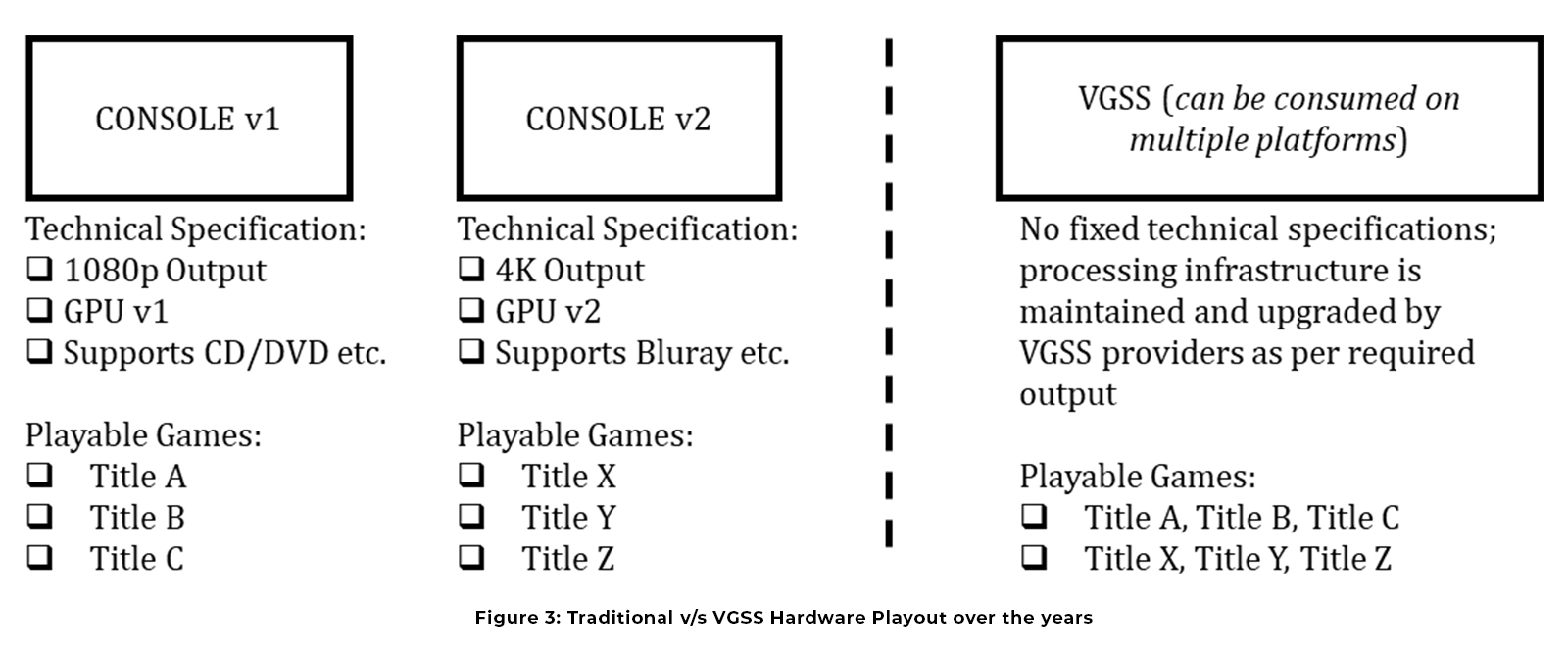Video Game Streaming Service: Benefits & Challenges
The dynamics of the video game industry is presently undergoing changes due to the internet. While it’s wide-spread availability has developed the e-sports scenario, the increasing speed has incentivised the developers to leverage it for bypassing hardware limitations and reach every corner via Video-Game Streaming Service (VGSS) aka Cloud Gaming.
What is VGSS?
A VGSS acts much like Netflix or Hulu: the game is developed by the studios, processed in the service provider’s GPU-augmented servers and the end-product i.e. the playable game is streamed to various consumer devices for entertainment.

Benefits of VGSS
The main advantage of VGSS – a customer only has to pay[ Pricing in the cloud gaming industry has still not been declared as of writing of this paper, as such it is a speculative guess based on trending news about the service charges] for the game title/subscription service he/she wants to play, select the device to be streamed to and play - no upgrading hardware, no confinement to a specific platform for enjoying a title. What this signifies is that unlike the modern consoles where one has to invest in the console in addition to the game he/she wants to play, in case of cloud gaming a person has to invest only in the subscription fee/game title. Moreover, in case of the traditional consoles, due to technical and graphical advancements a new version comes to the market with newer games being developed only for that console. This makes the older console obsolete. But not so in case of the cloud gaming platform as the graphical processing takes place in the cloud which is handled and maintained by the cloud gaming service provider. Also, cloud gaming enables mobility in gaming unlike the present consoles. A person can start a game on a TV and continue it over a mobile with high fidelity visuals as all the processing happens on the cloud.

Challenges in VGSS
In case of VGSS, certain disadvantages beset the streaming approach which has slowed down its mass market deployment and adoption. Dependence on inconsistent internet connection and latency issues. The present specifications in reference to internet speed laid down by the various VGSS provider ranges between 10 Mbps to 30 Mbps. Yet majority of the countries all over the world lack the speed necessary for smooth performance of games. For example while countries like US and UK enjoys internet speed in the range of 15-30 Mbps on average, in countries like India, the average speed ranges between 1-15 Mbps. This in turn leads to stuttering and latency issues in control and movement of in-game character models. In a cloud gaming environment, each input by a user is transmitted to the cloud, registered in the cloud environment and the corresponding action is then streamed to the user’s screen. With slow internet speed, the latency issue can cause severe gameplay issues to the extent that cloud gaming of a title may almost be impossible. But with advancing development on the internet infrastructure front through the release of faster internet connections (e.g. Jio Gigafiber in India), VGSS can become a viable and popular method of gaming for countries like India.

On the customer experience front
On the customer experience front, as with any new technology, challenges are expected to be faced by the customers at the initial stage. Yet Tech Mahindra’s omni-channel, multi-lingual front office operations can mitigate the challenges on behalf of the VGSS. Going a step further, Tech Mahindra also handles all the payment-related queries as well as based on the state an end-consumer is in, can engage in cross-selling and upselling of products and services on behalf of the VGSS, perform win-back operations for lapsed customers and get engaged in outbound collections and customer on-boarding, thus freeing up valuable resources for the VGSS for them to focus on the core technical service offerings.
On the content discovery front
To realise the full potential of cloud gaming and leverage its capacity for revenue generation, each VGSS has to ensure the maximum content discoverability and accessibility to its services beyond the service-enabling technical infrastructure. For one, metadata tagging of titles available in a particular provider’s platform will ensure easier content discoverability and categorization of the titles for firing up the VGSS’ recommendation algorithm. Secondly, localization of these metadata will ensure content discovery across different geographies thereby increasing the market reach of its content. In such a scenario, Tech Mahindra, with its automation-focused metadata extraction and tagging capabilities coupled with localization services can hugely boost the metadata scene of any VGSS.
On the platform security front
Cloud gaming opens up infinite possibilities on the social front: multiple gamers across geographies can join online to play a game concurrently, games can be started right from popular social feeds like YouTube (in case of Google Stadia)[ Announced but not confirmed] or gamers can play and live-stream it for the audience. In case of the latter, the live-interaction of the gamer with the audience exposes him/her to online bullying and make the cloud gaming platform unsuitable as a social platform, something antithetical to one of the core philosophies of cloud gaming. But with Tech Mahindra’s Human-in-the-Loop solution approach for content moderation of incoming communication feeds during a live-stream, the cloud gaming platform can be safeguarded against e-harassments.

In conclusion, while video game streaming service holds infinite potential for better accessibility of games for its customers, the limiting technological infrastructure coupled with the challenge of adapting the service to the changing online landscape should be tackled with urgency and Tech Mahindra, with its VGSS-aligned service offerings, can ensure a secure online platform localised for the various geography, thus delivering a great customer experience.









